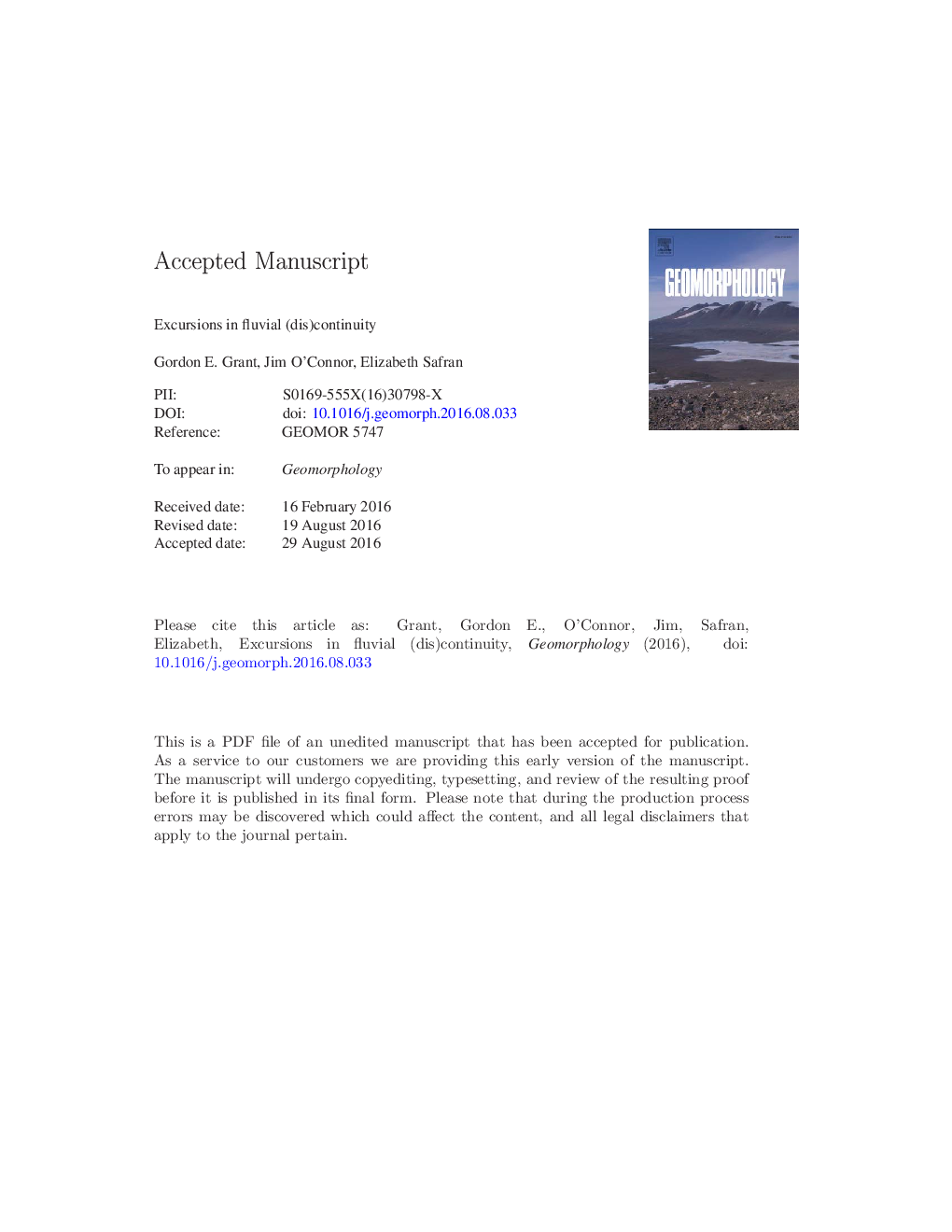| کد مقاله | کد نشریه | سال انتشار | مقاله انگلیسی | نسخه تمام متن |
|---|---|---|---|---|
| 5781142 | 1635372 | 2017 | 27 صفحه PDF | دانلود رایگان |
عنوان انگلیسی مقاله ISI
Excursions in fluvial (dis)continuity
ترجمه فارسی عنوان
گشت و گذار در جریان (جریان) تداوم
دانلود مقاله + سفارش ترجمه
دانلود مقاله ISI انگلیسی
رایگان برای ایرانیان
کلمات کلیدی
فرآیندهای جریان، تداوم، مدل های مفهومی، اتصال
ترجمه چکیده
در مقابل، دیدگاه متناوب، یک چارچوب مفهومی متمایز اما مؤثر است که تفکر غیر یکنواخت، غیر مترقبه و غیر تعادل را در درک فرآیندهای زمین شناسی و مناظر در نظر می گیرد. ما نمونه هایی از سه راه مختلف را تشریح می کنیم که در آن تفکر دائمی می تواند بیان شود: 1) ترتیب مکانی فصلی یا رویدادهای منحصر به فرد؛ 2) دامنه های فرایند خاص که به طور کلی با آستانه ها مرتبط هستند یا درونی یا بیرونی؛ و 3) دینامیک فیزیکی و یا تغییر در حالت، دوباره اغلب با آستانه مرتبط است. در حرکت به دور از دیدگاه مداوم، یک مجموعه باروری از ایده ها به تمرکز می رسد: آستانه ها، دولت های غیر تعادل، ناهمگن، فاجعه. طیف وسیعی از پدیده هایی که به علت کاوش علمی باز می شود، به طور مشابه گسترش می یابد: قسمت هایی از برش و پر شدن نقطه گذاری شده، تقسیم بندی مناظر به سلسله مراتب ساختار و کنترل، کار وقایع شدید. تکامل منظم و پیشرونده نسبت به یک حالت ثابت یا ایده آل، با وقایع ناگوار اختلال و بهبودی جایگزین می شود. تحولات اخیر در زمینه ژئومورفولوژی نشان می دهد که ما ممکن است بر پایه یک پارادایم جدیدی بنا بگذارد که به رسمیت می شناسد که هر دو فرایند و مکانیزم مستمر و غیر متمرکز در فرایندهای رگبار و تکامل چشم انداز نقش مهمی را ایفا می کنند، رودخانه ها همانطور که هستند.
موضوعات مرتبط
مهندسی و علوم پایه
علوم زمین و سیارات
فرآیندهای سطح زمین
چکیده انگلیسی
In contrast the discontinuous view is a distinct though complementary conceptual framework that incorporates non-uniform, non-progressive, and non-equilibrium thinking into understanding geomorphic processes and landscapes. We distinguish and discuss examples of three different ways in which discontinuous thinking can be expressed: 1) discontinuous spatial arrangements or singular events; 2) specific process domains generally associated with thresholds, either intrinsic or extrinsic; and 3) physical dynamics or changes in state, again often threshold-linked. In moving beyond the continuous perspective, a fertile set of ideas comes into focus: thresholds, non-equilibrium states, heterogeneity, catastrophe. The range of phenomena that is thereby opened up to scientific exploration similarly expands: punctuated episodes of cutting and filling, discretization of landscapes into hierarchies of structure and control, the work of extreme events. Orderly and progressive evolution towards a steady or ideal state is replaced by chaotic episodes of disturbance and recovery. Recent developments in the field of geomorphology suggest that we may be on the cusp of a new paradigm that recognizes that both continuous and discontinuous processes and mechanisms play a role in fluvial processes and landscape evolution with neither holding sway over the other and both needed to see rivers as they are.
ناشر
Database: Elsevier - ScienceDirect (ساینس دایرکت)
Journal: Geomorphology - Volume 277, 15 January 2017, Pages 145-153
Journal: Geomorphology - Volume 277, 15 January 2017, Pages 145-153
نویسندگان
Gordon E. Grant, Jim O'Connor, Elizabeth Safran,
